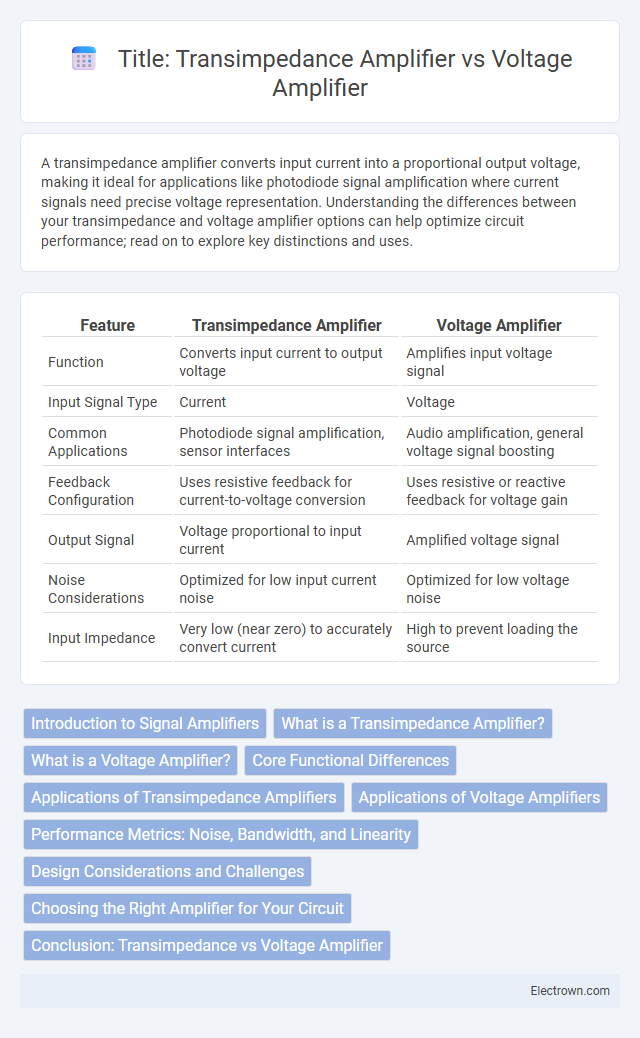A transimpedance amplifier converts input current into a proportional output voltage, making it ideal for applications like photodiode signal amplification where current signals need precise voltage representation. Understanding the differences between your transimpedance and voltage amplifier options can help optimize circuit performance; read on to explore key distinctions and uses.
Table of Comparison
| Feature | Transimpedance Amplifier | Voltage Amplifier |
|---|---|---|
| Function | Converts input current to output voltage | Amplifies input voltage signal |
| Input Signal Type | Current | Voltage |
| Common Applications | Photodiode signal amplification, sensor interfaces | Audio amplification, general voltage signal boosting |
| Feedback Configuration | Uses resistive feedback for current-to-voltage conversion | Uses resistive or reactive feedback for voltage gain |
| Output Signal | Voltage proportional to input current | Amplified voltage signal |
| Noise Considerations | Optimized for low input current noise | Optimized for low voltage noise |
| Input Impedance | Very low (near zero) to accurately convert current | High to prevent loading the source |
Introduction to Signal Amplifiers
Signal amplifiers convert low-level electrical signals into stronger outputs for easier processing, with transimpedance amplifiers (TIAs) and voltage amplifiers serving distinct roles in this process. A transimpedance amplifier directly converts input current into a proportional output voltage, making it essential for applications like photodiode signal amplification where current signals dominate. Voltage amplifiers boost voltage signals while maintaining input-output impedance characteristics, ideal for voltage-driven sources and circuits requiring voltage gain without current conversion.
What is a Transimpedance Amplifier?
A Transimpedance Amplifier (TIA) converts input current into a proportional output voltage, making it essential for applications involving photodiodes or sensors that produce current signals. Unlike voltage amplifiers, which amplify voltage signals directly, TIAs provide precise current-to-voltage conversion with high sensitivity and low noise. Understanding your application's current signal requirements ensures you select the right amplifier type for optimal performance.
What is a Voltage Amplifier?
A voltage amplifier is an electronic device designed to increase the voltage level of an input signal while maintaining the same waveform characteristics. Unlike a transimpedance amplifier that converts current to voltage, a voltage amplifier directly amplifies voltage with high input impedance and low output impedance, making it ideal for signal conditioning in audio, communication, and sensor applications. Understanding your requirements for signal type and source impedance helps determine whether a voltage amplifier or transimpedance amplifier best suits your circuit design.
Core Functional Differences
Transimpedance amplifiers convert input current signals into proportional output voltages, making them ideal for photodiode and sensor applications where current is the primary parameter. Voltage amplifiers amplify voltage signals without changing their type, commonly used when the input is already a voltage source requiring signal gain. The core functional difference lies in their input-output relationships: transimpedance amplifiers use feedback to establish a current-to-voltage transfer function, whereas voltage amplifiers simply provide voltage gain.
Applications of Transimpedance Amplifiers
Transimpedance amplifiers are widely used in photodetection systems, converting photocurrent from photodiodes into measurable voltage signals with high precision. They are essential in fiber optic communication, medical instrumentation such as pulse oximetry, and scientific research involving light detection. Unlike voltage amplifiers, transimpedance amplifiers excel in low-noise, high-speed current-to-voltage conversion for accurate signal processing in optical sensors.
Applications of Voltage Amplifiers
Voltage amplifiers are widely used in audio amplification, signal conditioning, and communication systems due to their ability to increase voltage signals with high input impedance and low output impedance. They are essential in sensors and instrumentation devices for amplifying voltage signals without significantly loading the source. In applications such as audio preamplifiers, radio frequency amplifiers, and measurement equipment, voltage amplifiers provide precise voltage gain and improved signal fidelity.
Performance Metrics: Noise, Bandwidth, and Linearity
Transimpedance amplifiers excel in converting current to voltage with low input-referred noise, making them ideal for photodiode signal processing, while voltage amplifiers typically exhibit higher noise levels in current-sensing applications. In terms of bandwidth, transimpedance amplifiers maintain wide frequency response due to feedback loop design, whereas voltage amplifiers may suffer bandwidth limitations caused by input impedance and parasitic capacitances. Linearity is often superior in voltage amplifiers for voltage-driven inputs, but transimpedance amplifiers deliver better linearity when handling low-level current signals, ensuring accurate signal amplification for Your sensitive measurements.
Design Considerations and Challenges
Transimpedance amplifiers require careful design to minimize noise and ensure stable feedback while accurately converting input current to output voltage, making them ideal for photodetector applications. Voltage amplifiers focus on maximizing voltage gain and bandwidth but face challenges such as input impedance matching and distortion reduction. Your choice depends on whether precise current-to-voltage conversion or high voltage gain is critical for the specific signal conditioning.
Choosing the Right Amplifier for Your Circuit
Selecting between a transimpedance amplifier and a voltage amplifier depends on your circuit's signal type and application requirements. Transimpedance amplifiers convert current signals from photodiodes or sensors into precise voltage outputs, ideal for low-level current detection. Voltage amplifiers are suited for circuits requiring voltage gain of line-level signals, making your choice critical for optimizing signal integrity and noise performance.
Conclusion: Transimpedance vs Voltage Amplifier
Transimpedance amplifiers convert current input signals into proportional voltage outputs, making them ideal for photodiode or sensor applications requiring precise current-to-voltage conversion. Voltage amplifiers, on the other hand, amplify voltage signals directly and are better suited for voltage-driven inputs with higher impedance. Your choice between a transimpedance amplifier and a voltage amplifier depends on whether you need accurate current measurement or voltage signal amplification.
Transimpedance amplifier vs voltage amplifier Infographic

 electrown.com
electrown.com